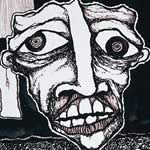It has pained me that I've never taken the time to focus on Clotfelter with an actual review, but part of that, beyond my own idleness (or if not idleness then a tendency to move slow and steady through life like maple syrup or a tortoise)/focus on my own art to the exclusion of writing about art (did I lose you there?), is his tendency to constantly be releasing in short bursts small projects (his own but also collaborations with other cartoonists) scattered like machine gun fire into the atmosphere. He doesn't stop long enough to issue a more comprehensive collection, which makes it hard for the reviewer to in turn stop long enough to issue a comprehensive survey. This is not a bad thing.
And I'm grateful that via the Atomic Books blog I was asked to list my top five books of the year, and I could easily say: any and everything Max Clotfelter has put out in the past year, as a single entry on that list (and, lets face it, Atomic's blog is gonna get more play for Max than me bellowing in my little personal dark corner of the digital universe, anyway). That brings us to today, in which I have the most recent batch of goodies Clotfelter sent me, and with the Atomic round-up behind me, my mind feels free and clear to simply look at the batch before me.
First of all, Max hits the page with the kind of detailed grotesque humor of a Basil Wolverton. Characters bumble through menacing landscapes that Rory Hayes would feel at home within. The layout and movement would not feel out of place in Kaz's Underworld, but whereas Kaz's drawings are clean in composition even at their dirtiest in content, Clotfelter gets right under every fingernail to render each piece of dirt heavy with his own expressionism, which slows time down and makes us linger for a while in each dingy panel or drawing.
If artists surveyed here recently like Dunja Jankovic and R. Clint Colburn are psychedelic in execution, Max is our guide exclusively through bad trips. While the calling card of Max's style is the firmly marked, etching-like firm clarity of his line, I like it when he loosens up into a more sweeping gestural squalor as in Good Deal #1, which is also in the running for the "best" bad trip of this bunch (that said every other piece in Andros #5 is a worthy contender). Often the characters seem like maybe they are so drunk that the experience resembles an hallucination, or so drunk maybe they've only imagined they've taken hallucinogens. In the small fold-out of Dawg Pond (along with collaborators Nikki Burch and Tom Van Deusen) the imaginings of the characters seem to take them to a place no better or worse than the twisted hells they actually inhabit; Max (along with his conspirators) says it's all the same on the grungy vaudeville stage of human life. And narratives are often difficult to discern as autobiography or fiction such as "My Mr. T. Experience" from Andros #5 (the larger collection of comics of the three), but, regardless, the joke is always going to be on his characters who are never safe, whether or not the characters might even be Max himself. Sober as a board, or bad tripping into infinity, one gets the idea that Max is telling us there's no difference between the two states of being, either way.
In a contemporary comics landscape where many of our young artists seem like twee precious/precocious little things like Aubrey Beardsley without the jam, lighting like fairies on the page lost in wonder and abstraction, often with a watered down Henry Darger influence ("sexy babies," a term my friend Caitlin has coined for these types), Max pukes on that for us, for he has more in common with Hieronymus Bosch and Brueghel the Elder: with Clotfelter, it's foibles, not fables. His world is violent, perverted, and always pregnant with danger and his vision does not reside in the right tax bracket or take the right medication to regard it otherwise. He finds the humor in all of it and draws it. And I am thankful that we all have a artist like that among us.







